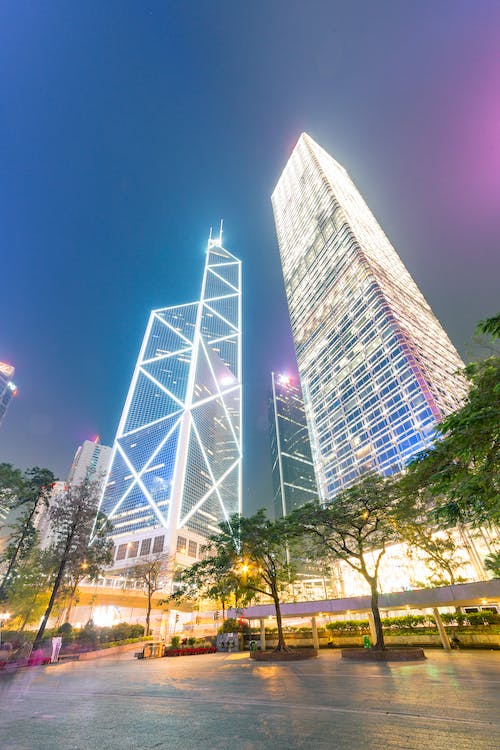What exactly is commercial lighting?
Table of Contents
Toggle
Whether at an office or a mall, lighting is a fundamental requirement. Staff can complete their tasks with the help of proper lighting, which improves a business’s seamless operation. Over the past few years, there have been significant developments in the lighting sector. Technology development has led to the creation of more effective, energy-saving lighting options. These green lighting choices have gained a lot of popularity, especially with the commercial use of LED lights.
Commercial lighting is a broad category that covers lighting for a variety of establishments, including shops, offices, institutions, restaurants, hospitals, hotels, and shopping centres. Keep in mind that lighting systems for factories, public buildings, and roadways are all regarded as being part of the commercial lighting category. Commercial lighting generally differs from residential lighting in terms of price, lifetime, durability, energy-saving features, service charges, and maintenance. In a minute, we will examine these distinctions in greater detail.
The major goal of making an appropriate investment in a dependable commercial lighting system is to optimise your business environment for return on investment.
Even though some of these advantages could be imperceptible and challenging to see, using highly efficient business lighting fixtures for your workspace will grow your company and produce returns. The commercial lighting system you select should: • Boost employees’ output and performance. • Make sure consumers or clients are made to feel welcome. • Make it easier to move around the property from one area to another.
>Reduces the price of energy.
>Include the sun and other natural light sources.
What distinguishes residential lighting from commercial lighting?

At first, many people find it difficult to understand the distinction between residential and commercial lighting. This situation is terrible because understanding the differences between the two makes it easier for someone to select the lighting that best meets their needs.This information can help a business owner create the ambience they need to pacify customers, boost sales, or even brighten the baby area at a theme park.
There are several distinctions between commercial and residential lighting in the following areas:
Quality
Compared to domestic lighting systems, commercial lighting systems are often of higher quality. Because they are constructed with better modules, drivers, and heat sinks, among other components, they survive longer than their residential counterparts. Additionally, the main function of commercial lighting encourages increased client connection, which helps the manufacturers understand the particular requirements of the customers.
Longevity
Typically, commercial luminaires outlast their residential counterparts in terms of durability. The quality of the materials utilised is largely responsible for the durability of commercial-grade lighting systems. Commercial luminaires can withstand challenging environments and provide longer service hours thanks to additional features like heat management capabilities and IP ratings.
Serviceability Depending on the needs of your company, a tailored plan for commercial light maintenance can be developed around a timeframe of monthly, bi-monthly, quarterly, or semi-annually. Commercial lights typically have longer service lives, which lowers the maintenance costs compared to residential lights.
Additional Options One of the fundamental parts of both business and residential lighting systems is a light source.Commercial lights, however, have extra parts that frequently improve the user’s experience.Photocells, motion detectors, battery backups, shields, etc. are some examples.Consider the benefits of a motion sensor on an LED commercial lighting.
Important Components of Commercial Lighting
We’ve already discussed the advantages of commercial lighting solutions for businesses. It is crucial to remember that advantages aren’t always automatic. To put it simply, there are a number of steps you must follow to take advantage of these benefits. For instance, you should take into account the following crucial lighting components:
Direction The perception of your business’s surroundings and topic matter is influenced by the lighting direction.You may control the outcome or the environment you want to create on your property by changing the light’s direction. Often, it’s all about getting the most coverage for your money, like in an LED wall pack light.The best direction for your lighting should be determined by what you hope to accomplish with it.
Intensity
The term “intensity” is used to describe the brightness level of a light and how it interacts with other lights around it. Commercial lighting must be intense since lighting ratios greatly affect the ambiance that is established in a particular place.For instance, to set a particular ambience, lighting fixtures of varying intensities are used in restaurants. Similar to that, a workshop space where precise work is done needs between 500 and 700 LUX.
Softness
A light source’s softness refers to how harsh or gentle it is on an object. Your subject will appear more welcoming and pleasant in soft light, which has a more natural appearance. Soft light is more attractive than hard light.
Simply put, the softness of the light has the power to elevate or detract from the emotional atmosphere of your environment. The popularity of soft light in photography and filmmaking is due to its capacity to reduce the appearance of shadows, blemishes, and wrinkles. Soft living contributes to aesthetics.
Hard light, on the other hand, draws attention to changes in shape, contour, and texture. also often used in photography and film.
Colour
The colour temperature, or how warm or cool your light is, determines this final facet of commercial lighting.
While bluer tones frequently feel more dismal and icier, yellower tones typically feel happier and cosier. Contrasting tones can be used to further convey emotion, although skin tones appear better than this.
The preferred colour is now 5000K, brilliant daylight white, for outdoor installations and large areas like warehouses. Offices are frequently thought to benefit from neutral or cold colour temperatures (between 3000 K and 4000 K). Cool lighting between 3500 and 5000 K is beneficial for hospitals and other medical facilities, as these colour temperatures promote focus and alertness.
Top 5 considerations when purchasing commercial lights

Commercial lighting goods are in high demand, and as a result, more lighting firms are now creating them. As a result, there are many different types and brands of commercial lighting products available on the market today. These goods come in a variety of quality levels. You should look for these types of commercial lighting. Despite the difficulties in selecting the ideal commercial lighting system, taking the following elements into account can be useful:
- Cost-effectiveness – A firm must consider the cost of its lighting systems, which includes the original investment, energy expenses, installation costs, replacement costs for fixtures, and maintenance costs. Businesses should use lighting fixtures and lighting designs that have the most impact. Making the most of natural light and choosing energy-efficient light bulbs can both be beneficial.
- Robustness – Search for lighting fixtures that were made from premium materials. Such commercial lights feature long lifespans and low maintenance costs. Investing in high-quality lighting fixtures guarantees that they will last for many years. Selecting a commercial light is crucial, particularly in high warehouses or parking lot lighting where a lift rental is necessary. Always pay attention to the driver because lifespan depends on a high-quality isolated driver.
- Aesthetics – Your lighting fixture’s appearance and the atmosphere it creates should always be taken into account jointly. It would be beneficial if you could decide whether the lighting scheme is suitable for your room. Ensure that it emphasises the accessible features while concentrating on the main topic of interest. There are times when lighting creates a certain atmosphere in a room.
- Light Output – Because LED lighting is more cost-effective and has a higher lumen output than fluorescent and high-intensity lighting systems, utilise it whenever possible. Consider establishing an integrated building control management system if you want to monitor your energy usage and automate settings as needed. Thankfully, a variety of lighting alternatives that can solve all of these problems are now readily available.
- Application – In specialty applications like solar lights, UV-C disinfectant lightsor Grow lights – commercial becomes even more critical.It’s simply to easy to be sold something that isn’t in these applications, You are not going to test the spectrum of UV-c
Who Qualified it to be Commercial?

Currently, no institution qualifies lighting systems as either commercial, industrial, or residential. Things would be easier and manageable if a regulatory body were mandated to qualify lighting fixtures as residential or commercial or otherwise. This phenomenon means that you must research for yourself whether a lighting fixture is commercial-grade.
Some key factors you should keep in mind while selecting commercial lights in India:

When selecting commercial lights in India, there are several important aspects to consider:
Energy Efficiency:
Look for lights that are energy-efficient and have a high luminous efficacy. LED lights are the most popular choice for commercial applications due to their energy-saving capabilities and long lifespan.
Brightness and Light Output:
Consider the required brightness level for your commercial space. Different areas may require different levels of illumination, so choose lights with appropriate light output (measured in lumens) to meet your specific needs.
Color Temperature:
Determine the desired color temperature of the lights. It refers to the appearance of the light, ranging from warm (yellowish) to cool (bluish) hues. Select the color temperature that aligns with the purpose and ambiance of your commercial space.
Durability and Lifespan:
Opt for lights that are durable and have a long lifespan, as commercial spaces typically require lighting to operate for extended periods. LED lights are known for their longevity, and they can withstand frequent switching and various environmental conditions.
Maintenance and Ease of Installation:
Consider the maintenance requirements and ease of installation for the lights. Choose fixtures that are easy to install and maintain to minimize downtime and additional costs.
Lighting Controls:
Evaluate if you need lighting control systems for your commercial space. This could include dimming capabilities, occupancy sensors, or daylight harvesting to enhance energy efficiency and tailor lighting levels to specific areas.
Compliance with Standards:
Ensure that the lights you select comply with relevant Indian standards and regulations, such as the Bureau of Indian Standards (BIS) or the Energy Efficiency Services Limited (EESL) labeling requirements for energy-efficient products.
Cost and Return on Investment:
Consider the initial cost of the lights and weigh it against the potential energy savings and long-term return on investment (ROI). LED lights may have a higher upfront cost but can save significant energy and maintenance expenses over time.
Warranty and After-Sales Support:
Check the warranty period offered by the manufacturer or supplier. Also, inquire about the availability of after-sales support, including repair and replacement services.
Environmental Impact:
Consider the environmental impact of the lights you choose. Opt for lights that are free from hazardous substances and are recyclable to minimize the carbon footprint of your commercial space.
By carefully considering these aspects, you can make an informed decision when selecting commercial lights for your space in India.
Conclusion:
Choosing the right commercial lighting is vital for creating an optimal workspace. Consider factors like energy efficiency, durability, and customization options. Illuminate your commercial space effectively and efficiently with high-quality lighting solutions from Illustrious. Visit https://illustrious.co.in today and transform your workplace into a brighter and more productive environment.
